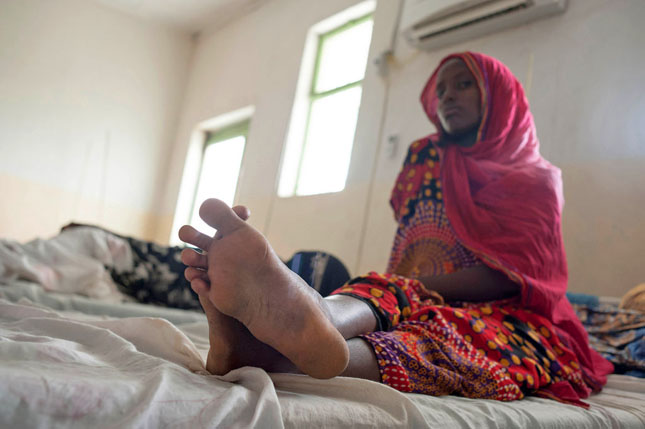-
In Fight to Stop the Spread of Female Genital Mutilation, Midwives Are Crucial
December 23, 2015 By Francesca Cameron
Aissata M.B. Camara grew up in an educated, upper income household in Guinea, West Africa. One morning, she woke up to singing outside her window and knew they were coming. Many in her community thought that she was unclean and would grow up to be promiscuous if she wasn’t cut. She would be unmarriageable. While her family and community members held her down, she realized, “my body no longer belonged to me.” [Video Below]
Camara, now an anti-female genital cutting activist based in the United States and co-founder of the There Is No Limit Foundation, spoke at the Wilson Center September 14. While respecting cultural traditions is important, protecting the rights of girls and women takes precedence, she said.
“To allow for every child, every girl to have the full experience of life, including sexual experience, that’s a human right,” agreed U.S. Congressman Joseph Crowley, who has sponsored a law to make it harder for girls to be taken outside the United States to be cut and then returned.
A Spreading Phenomenon
Although Camara said she felt betrayed by the people she had trusted all of her life, she understood the immense familial and communal pressure faced by her parents in Guinea.
Every year, an estimated three million girls are at risk of undergoing female genital cutting (FGC), also known as female genital mutilation (FGM), which includes all procedures involving partial or total removal of the external female genitalia or other injury to the female genital organs.
“My body no longer belonged to me”Between 100 million and 140 million girls and women are living today with these scars across sub-Saharan Africa and the Middle East. Twenty-nine countries in Africa actively practice FGM, and it is spreading to other continents, including Australia, North America, and Europe. In many communities it is considered the normal way to welcome girls into womanhood.
But for survivors of FGM, the consequences of the procedure follow them for a lifetime.
Nicole Warren, a nurse and assistant professor at Johns Hopkins University, said there can be short-term complications to the procedure, including bleeding, genital tissue swelling, infection, and urination problems. Girls may also face obstetric complications down the line, like prolonged labor, tears, obstetric hemorrhage, and higher chances doctors will want to perform a Cesarean section, which is riskier for the mother’s health. Fear and post-traumatic stress disorder are common psychological effects too.
Congressman Crowley pointed out that while FGM is illegal in the United States, some immigrants take their daughters back to their home countries and force them to undergo the procedure. While there is a dearth of evidence on the prevalence of these cases – they are by nature difficult to detect – they do occur and girls need to be protected, he said. To this end, Crowley introduced the Girls’ Protection Act in 2011, which imposes a fine and/or prison term to those who transport girls outside of the United States for the purpose of FGM.
Health Workers as Advocates
A practice so deeply rooted in culture requires a holistic approach that engages and challenges communities. Crowley, Lal, and Aissata all affirmed the vital role of midwives and other community health workers as entry points into households. As trusted members of their communities, frontline health workers have the knowledge and understanding to navigate cultural sensitivities and convince families not to cut their daughters. However, they also face financial and social pressures to perform FGM.
In the United States and other migrant destination countries, medical staffs often don’t know enough about FGM and what complications or stigmas might be associated with it, said Warren.
To empower health workers, the United Nations Population Fund (UNFPA) has combined two global programs, said Lal: the UNFPA/UNICEF Joint Program on FGM/C, which is active in 17 countries, and the Global Midwifery Program, which is active in 65 countries. Through this joint initiative, UNFPA is doing sensitization, training, and skill-building for midwives so that they can act as role models, counselors, and advocates for the abandonment of FGM. A multimedia e-learning module for midwives is also on the way, said Lal.
Midwives and frontline health workers are just the starting point, said Nafissatou Diop, coordinator of the UNFPA/UNICEF Joint Program. In order to eliminate FGM within one generation – the goal of the United Nations – families, religious leaders, civil societies, and governments need to come together and decide they will no longer accept it as the norm in their communities, she said.
“We cannot have culture as a reason that we’re going to continue cutting people,” said Camara. “FGC is not just about culture. At the root, it is about human rights.”
Event Resources:
- Aissata M.B. Camara’s Presentation
- Geeta Lal’s Presentation
- Nicole Warren’s Presentation
- Photo Gallery
- Video
Sources: UN Population Fund, U.S. Department of Health and Human Services, World Health Organization.
Photo Credit: A pregnant teenager who was cut as a child is treated in Mille, Ethiopia, courtesy of Tsegaye/UNICEF.
Topics: Africa, development, Dot-Mom, featured, From the Wilson Center, GBV, gender, global health, Guinea, human rights, maternal health, Middle East, midwives, migration, population, Sahel, U.S., UN, UNFPA, video, youth
 A Publication of the Stimson Center.
A Publication of the Stimson Center.



